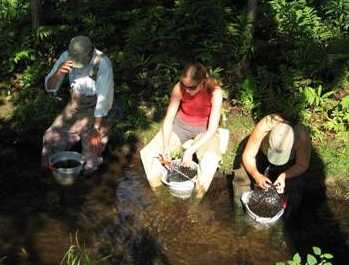Home → Water Quality → Monitoring & Reporting → Biomonitoring → Sampling & Analysis → River & Stream Macroinvertebrate Sampling
 Macroinvertebrate Sampling in Rivers & Streams
Macroinvertebrate Sampling in Rivers & Streams
Site locations & rationale
The Biological Monitoring Program has monitoring stations on rivers and streams distributed throughout Maine. Some of these monitoring stations have been sampled annually since the program's inception in 1983. Samples are collected from rivers and streams ranging from minimally disturbed reference sites to sites that are severely degraded. The sampling season is restricted to July through September so that macroinvertebrate communities are assessed during times of maximum stress caused by high temperatures, low concentrations of dissolved oxygen, and low flow levels.
Sampling is conducted to assess the health of waters potentially impacted by non-point source pollution such as fertilizers and pesticides carried by stormwater runoff, as well as by point source discharges.
Sampling methods
The abundance and generic richness of a macroinvertebrate community in a river or stream is determined by counting the number of species or genera in a standardized sampling unit-either a rock bag, rock basket, or cone, depending on water depth where the sample is taken.
Rock-filled mesh bags or rock baskets are used for the majority of wadeable sites. Rock bags allow sampling in depths as shallow as five centimeters, and can be flattened to fit stream bed contours.
Remote-retrievable rock-filled cone samplers allow for sampling in sites that are not wadeable. These devices are retrieved by boat using a weighted, funnel-shaped apparatus that is dropped down a line to settle over the cone. The base of the cone is fitted with Nytex mesh to prevent the loss of organisms upon retrieval of the sampling device. The cone results are similar to those of the rock-filled mesh bags and baskets.
All sampler types are usually placed on the stream bottom for four weeks before they are retrieved, though an eight week time period is sometimes used in impoundments. During this time macroinvertebrates colonize the cobble habitat contained within the sampling device. Upon retrieval biologists collect and preserve all accumulated material from the samplers. Physical data is also collected at each site. Examples of physical data include water velocity, dissolved oxygen, temperature, conductivity, substrate composition (sand, gravel, stones, etc), and a physical description of the site and surrounding area (amount of tree cover, land use, etc).
In the laboratory macroinvertebrates are separated from sediment and debris and identified to the lowest possible taxonomic level (usually genus or species). The macroinvertebrate data, along with information characterizing a site's physical characteristics and water chemistry, are entered into a relational database for statistical analysis.
Data analysis
All waters in the State of Maine have been assigned a legal classification by the Maine legislature. A multivariate statistical model designed and used by the Biological Monitoring Program uses macroinvertebrate data collected from rivers and streams to determine the likelihood that a sampled water body is attaining its designated class. The statistical model uses linear discriminate functions to classify sampling sites according to the standards in the aquatic life use classification system. Simply put, this model provides a way of using numeric data, such as generic richness and total abundance, to determine if samples are attaining desired biological criteria (A, B, or C) in a way that is reproducible and scientifically rigorous.
The model used by the Biological Monitoring Program was developed by statistically screening a set of significant, measurable ecological attributes associated with each narrative standard for their success at distinguishing between classification groups (A, B, C, and non-attainment (N/A). Of these screened attributes, twenty-six were retained for inclusion in the final set of functions comprising the model currently in use. The model determines the probability of a sample attaining class A, B, or C conditions. Biologists use the model results and supporting information to determine if samples attain conditions of the class assigned to the stream or river.
For more information on how the Biological Monitoring Program samples macroinvertebrates from rivers & streams, please visit our Materials Page.